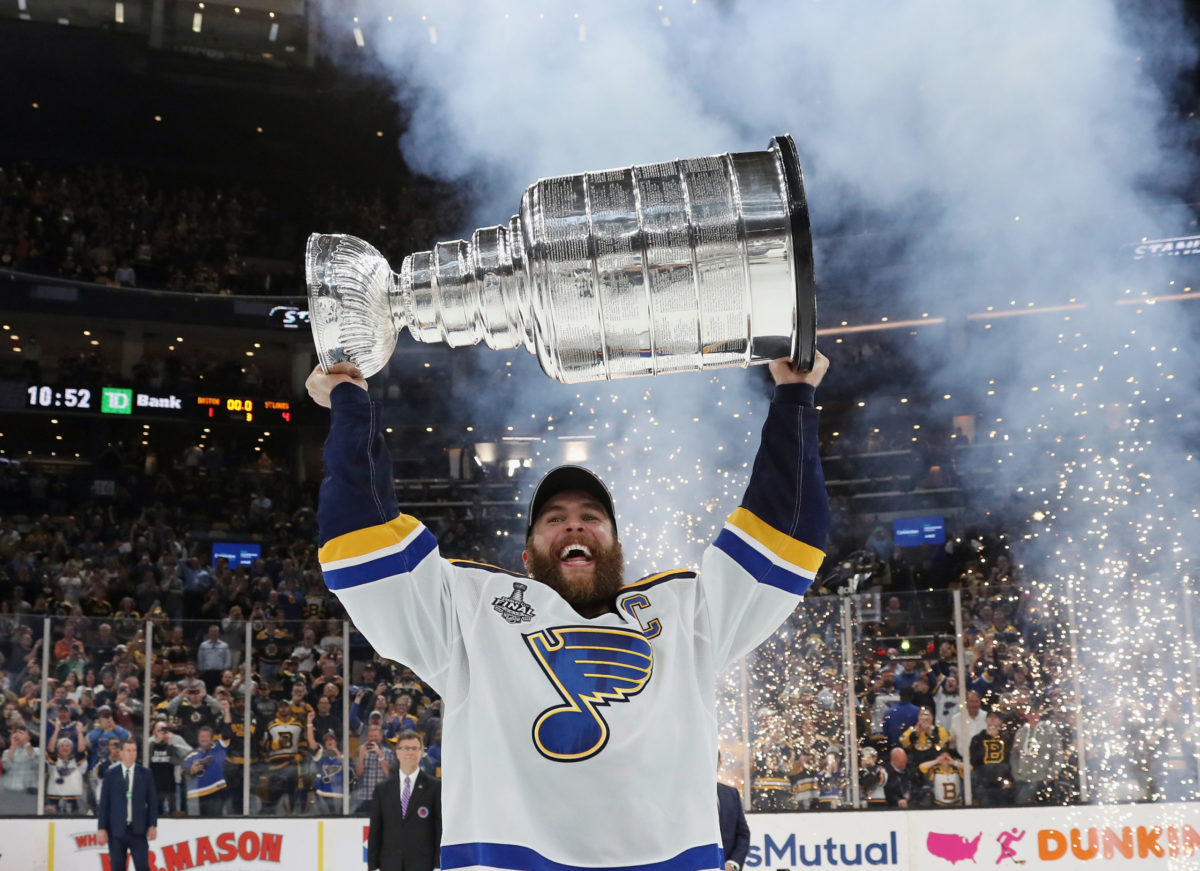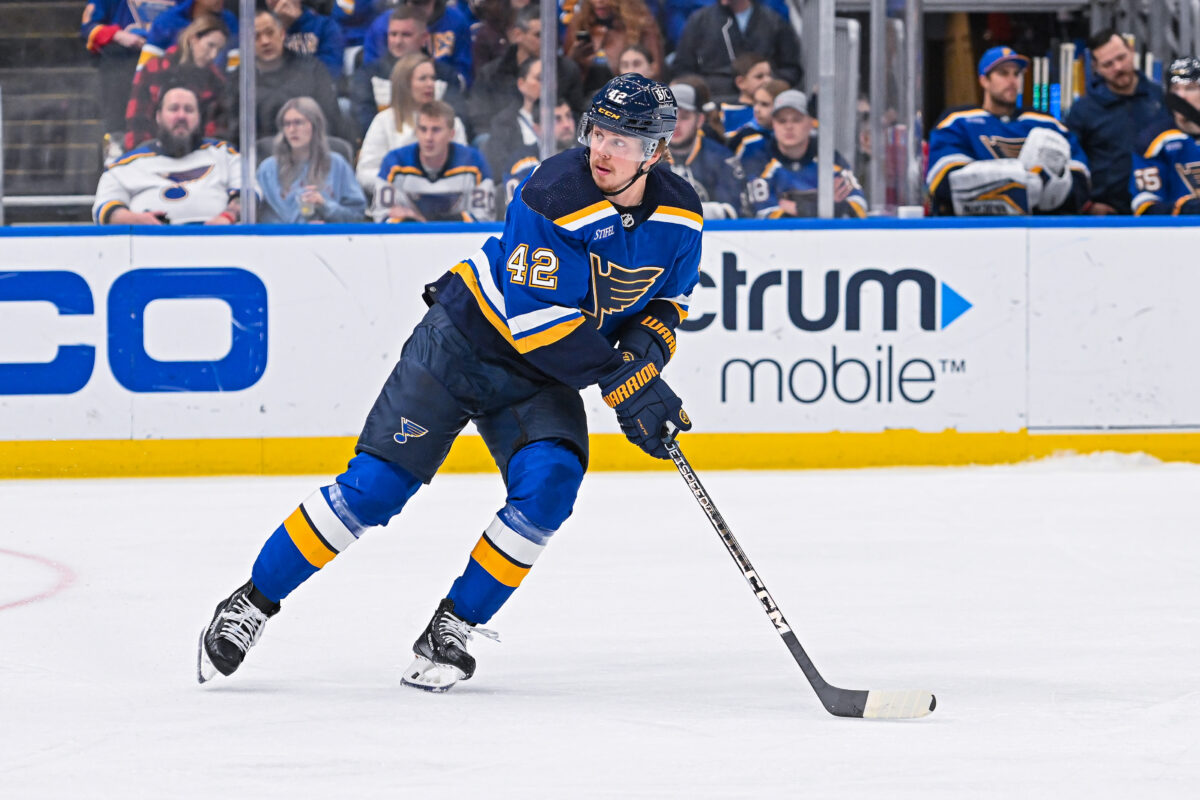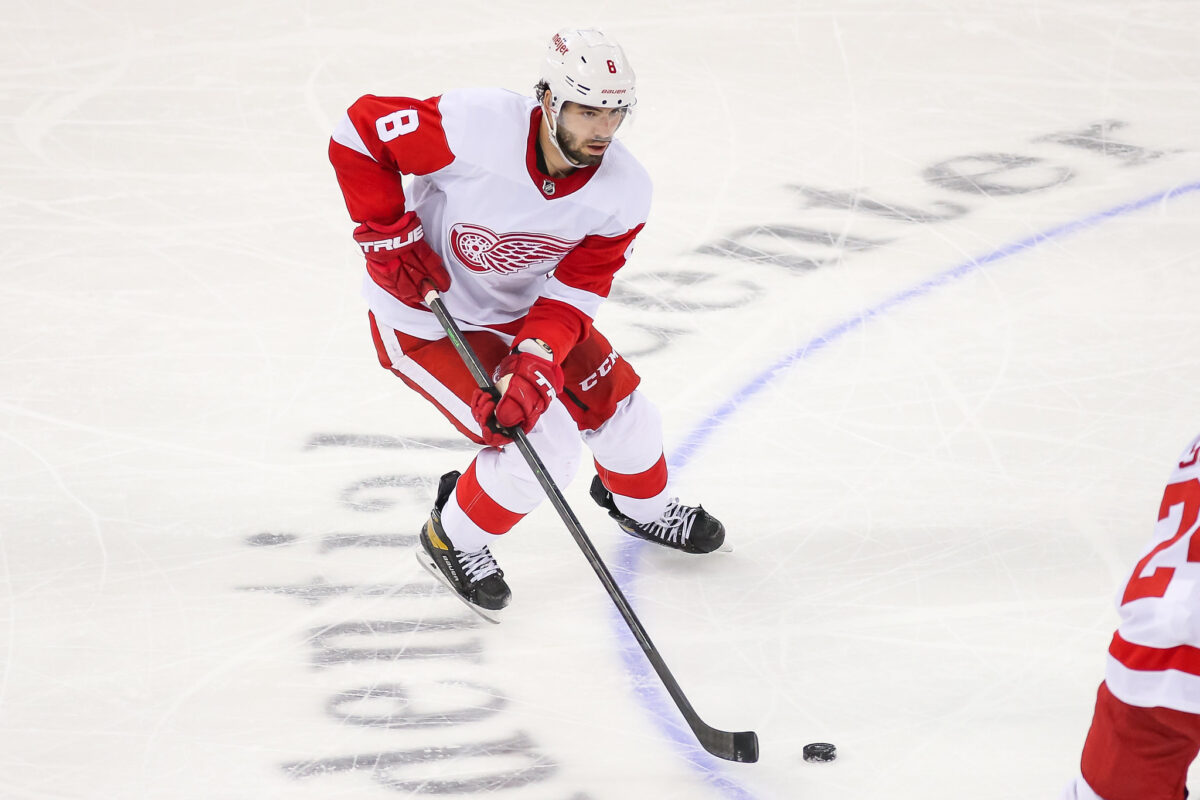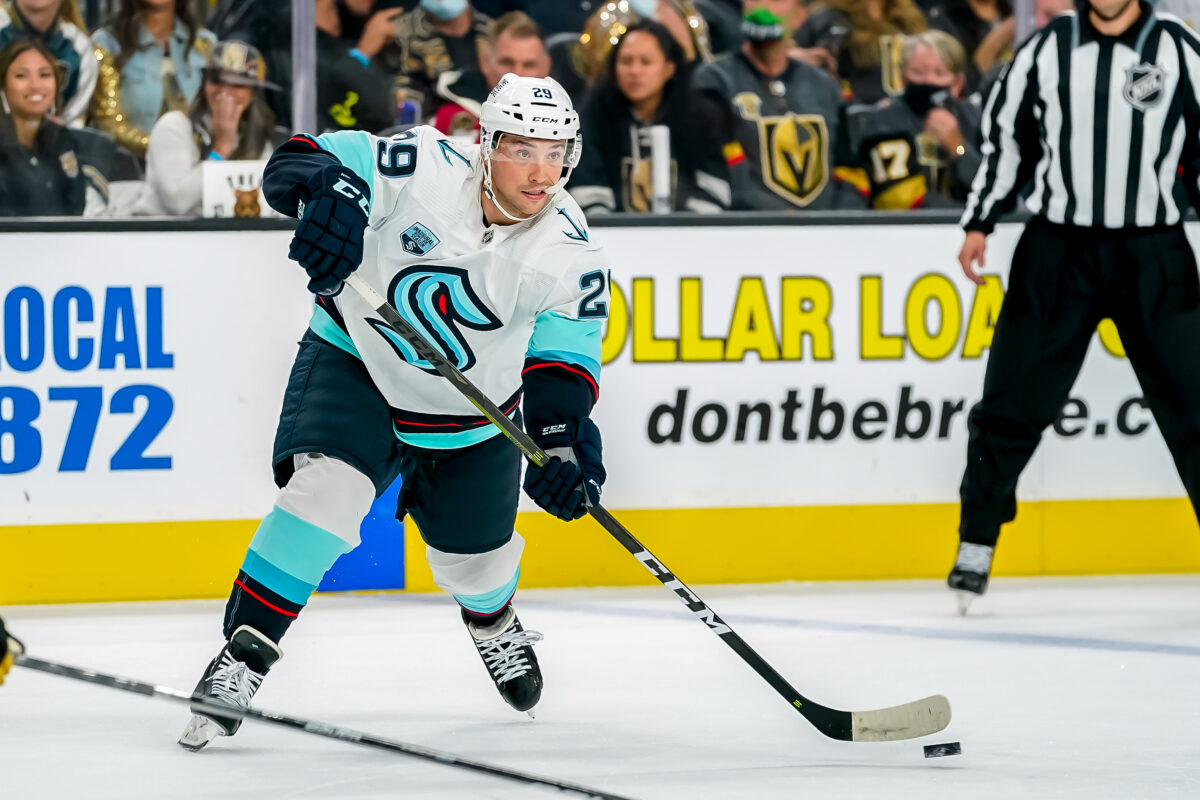The St. Louis Blues‘ decision to let Alex Pietrangelo depart in free agency and sign Torey Krug and Justin Faulk as replacements has been contentious. While Pietrangelo has thrived with the Vegas Golden Knights, helping them secure a Stanley Cup victory in 2023, the Blues have faced challenges in filling the void left by his departure.

The Blues’ strategy of prioritizing quantity over quality on defense has been met with criticism, especially as Pietrangelo continues to excel elsewhere. The perceived downgrade in defensive prowess with Krug and Faulk has been a point of contention among Blues fans and analysts alike.
While Krug and Faulk have had their moments of success with the Blues, they have not been able to replicate Pietrangelo’s leadership and defensive impact on the ice. This decision has contributed to the perception that management makes questionable moves and has failed to maintain the team’s competitiveness. With the Blues on the brink of missing the playoffs for the second straight season, there are several moves Armstrong has made that got St. Louis to the point of mediocre inconsistent hockey.
Signing Torey Krug
Krug’s performance has been heavily scrutinized, particularly due to his declining speed and tendency to turn over the puck in transition, leading to scoring opportunities for the opposing team. This trend has persisted for multiple seasons, raising concerns about his overall effectiveness. Despite expressing his intention to finish his career in St. Louis, the Blues may consider moving Krug.
With a defensive efficiency rating of only seven percent, Krug’s defensive contributions have become increasingly limited, highlighting the one-dimensional nature of his game. While he excels in the offensive zone, particularly on the power play, his defensive shortcomings have become a significant liability for the team.
At his current performance level, Krug’s hefty contract of $6.5 million may not be justifiable, especially if his on-ice performance continues to impact the team’s success negatively. As the organization evaluates its options, finding a solution to Krug’s declining performance will be crucial in determining his future with the team.
Trading for Justin Faulk
As for Faulk, injuries have hampered his performance, and when he has been on the ice, he has struggled to produce offensively and has been inconsistent in the defensive zone. While he was once considered one of the Blues’ top defensemen, the emergence of Colton Parayko has diminished his role within the organization.
Faulk was brought in to bolster the Blues’ defensive core. In his first season with the team, he showed promise but was inconsistent. However, he seemed to find his stride in the following season, demonstrating solid defensive skills and discipline. Comparing Faulk’s statistics from the 2021-22 season to his performance this season provides a clear picture of his regression. His numbers have declined across various metrics, raising concerns about his ability to return to his previous level of play.
| 2021-22 | 2022-23 | 2023-24 |
| Games Played: 76 Goals: 16 Assists: 31 Points: 47 +/-: +41 Offensive Impact: 88 Defensive Impact: 48 Entry passes: 81 Carries: 84 | Games Played: 82 Goals: 11 Assists: 39 Points: 50 +/-: -4 Offensive Impact: 65 Defensive Impact: 3 Entry passes: 83 Carries: 86 | Games Played: 40 Goals: 2 Assists: 17 Points: 19 +/-: -5 Offensive Impact: 75 Defensive Impact: 24 Entry passes: 61 Carries: 73 |
Overall, Faulk has fallen short of expectations this season, leading to uncertainty about his future with the Blues, and whether he can rediscover the form that made him a key contributor to the team in previous seasons.
Picking up Kasperi Kapanen
Kasperi Kapanen’s performance this season has been far from impressive. Despite his reputation for solid defensive play, his defensive performance has been lackluster, reflected in his minus-8 rating. Additionally, Kapanen has struggled to make a significant impact on the scoresheet, tallying just 15 points in 51 games.
Delving into the advanced metrics on Andy & Rono provides further insight into Kapanen’s struggles. With an overall rating of 17, his performance in 5v5 situations, transition, and defense has been abysmal.

His offensive metrics also show poor ratings across the board, including an offensive impact rating of 24, a shooting rating of 2, a passing rating of 58, and a point production rating of 14. Despite being recognized for his defensive abilities, Kapanen’s defensive metrics are also below average, with ratings of 36 for defensive impact, 50 for recoveries, and four for penalty kill.
Overall, Kapanen’s inability to live up to expectations has been detrimental to the Blues, especially considering the opportunities his presence has denied to promising young players like Zachary Bolduc and Zach Dean. As a result, this experiment can be deemed a failure, highlighting the need for a reassessment of Kapanen’s role within the team.
Signing Jakub Vrana
Jakub Vrana‘s tenure with the Blues has been marked by struggles, particularly in his defensive play. Despite possessing a powerful shot, Vrana’s defensive IQ, awareness, and physicality have been lacking, rendering him a liability on the ice. Initially seen as a potential replacement for Vladimir Tarasenko as a top-tier goal scorer, Vrana’s season took a downturn with a hesitant approach to shooting the puck. This led to his demotion to the American Hockey League (AHL), where he currently plays.
In contrast to Kapanen’s 51 games with the Blues this season, Vrana has only appeared in 21 NHL games. Despite being graded slightly higher than Kapanen, with a 31 overall rating on Andy & Rono, Vrana’s time in the NHL has been disappointing. In 21 games, he has two goals and four assists. His offensive impact rating of 73 is surprisingly high, considering his lack of production. However, his point production rating of 53, shooting rating of 44, and passing rating of 67 are all below average.
Moreover, his performance in key metrics falls short of expectations, with only his high-danger assists rating reaching above-average levels at 76. Every other metric, including his defensive play, is considered below average or lower.
Despite excelling in the AHL during his stint there, Vrana’s inability to translate his performance to the NHL level has raised questions about his future with the team. While he has shown flashes of potential, his inconsistent play and defensive deficiencies have overshadowed his offensive abilities.
Related: 3 Deadline Moves the Blues Could Make to Surprise Fans
As the Blues assess their roster and make decisions regarding player personnel, Vrana’s underwhelming performance may make him a candidate for trade or further development in the AHL. However, given his potential and offensive impact rating, the Blues may opt to give him more opportunities to prove himself at the NHL level before making any definitive decisions about his future with the team.
The Jake Walman for Nick Leddy Trade
The trade involving Oskar Sundqvist and Jake Walman for Nick Leddy was designed to strengthen the Blues’ defensive depth with a seasoned veteran. Leddy’s extensive experience in the NHL was expected to bring stability and leadership to the team’s blue line. However, upon further analysis via Jfresh Hockey, the notable differences between Leddy and Walman in terms of performance and potential are apparent.
| Jake Walman | Nick Leddy |
| Games Played: 52 Goals: 11 Assists: 9 Points: 20 +/-: +10 Offensive Efficiency: 80 Defensive Efficiency: 65 WAR: 78 | Games Played: 57 Goals: 3 Assists: 18 Points: 21 +/-: +12 Offensive Efficiency: 53 Defensive Efficiency: 26 WAR: 43 |
Leddy, with his 14-year NHL career, undoubtedly offers valuable experience and a proven track record at the highest level of competition. However, Walman’s age and potential for growth would have been better long-term for the Blues. Only five years into his professional career, Walman already possesses promising skating abilities and offensive skills that align with the team’s need for speed and agility on defense.

While Leddy may have provided immediate stability, the decision to trade Walman may have overlooked his long-term potential and developmental opportunities as part of the Blues’ defensive core. In retrospect, prioritizing short-term gains with Leddy’s experience may have come at the expense of addressing the team’s evolving needs and fostering future growth within the organization.
Acquiring Kevin Hayes
The acquisition of Kevin Hayes during the off-season has not yielded the desired results. In 57 games with the Blues, Hayes has failed to meet expectations and has been graded below average in terms of his on-ice performance, registering a 32 overall rating according to Andy & Rono.
Hayes lacks the ability to skate in transition and move the puck consistently. He constantly looks lost on the ice and makes bad decisions due to a lack of ability to play with some of the Blues’ younger and faster playmakers. His inability to keep up with the speed of this team causes Hayes to be one step behind, leading to poor play.
According to Jfresh, Hayes’ wins above replacement (WAR) percentage stands at a low 39, indicating that he has not been a significant contributor to the team’s success. His offensive efficiency rating sits at 51 percent, while his defensive efficiency rating is notably lower at 23 percent. Moreover, his offensive impact rating is just 22, underscoring his limited offensive contributions, while his defensive rating is slightly higher at 52.
One factor that may be contributing to Hayes’ underwhelming performance is that his style of play does not align well with the fast-paced system preferred by the Blues. With a roster consisting of players known for their speed and skating ability, Hayes’ slower pace and limited carrying and entry-passing ratings of 6 and 25, respectively, may be hindering his effectiveness.
Overall, Hayes’ acquisition has not provided the boost to the Blues’ lineup that was anticipated, and his struggles to integrate into the team’s style have raised questions about his long-term fit with the organization.
Letting Vince Dunn Go
Vince Dunn‘s departure in the expansion draft to the Seattle Kraken has left many fans questioning the decision. While Dunn was never known for his defensive reliability during his time with the Blues, his youth and potential were evident, and his absence has been felt by the team.
Now thriving with the Kraken, Dunn has established himself as a consensus top defenseman in the league and a top-100 player overall. Blues fans have expressed frustration with the current defensive lineup, particularly with Leddy not performing as a top-pairing defenseman and Krug facing criticism as a potential replacement. With Parayko’s emergence as a top-pairing defenseman, getting him a counterpart who can keep up with his pace in transition, and execute in the offensive zone would not only better the Blues, but allow Parayko more opportunities to grow as a player.
Reflecting on Dunn’s performance with the Kraken this season only adds to the regret. In 54 games, he has an impressive 11 goals and 32 assists. His advanced metrics further highlight his offensive reliability, with ratings well above average across the board. Offensively, Dunn excels with an offensive efficiency rating of 93 percent, showcasing his ability to generate scoring opportunities and contribute to goal production. His passing, shooting, and power play ratings are also impressive, reflecting his impact on various offensive aspects of the game.
While Dunn’s defensive metrics do not match his offensive performance, it was his offensive skill set that made him a valuable asset. While in Seattle Dunn has lacked a consistent productive partner next to him on the blue line which negatively impacts his defensive metrics. With a defensive efficiency rating of 22 and a defensive impact rating of 32, his defensive contributions are less than ideal. Pairing him with a defensive anchor like Colton Parayko would take some pressure off of Dunn in the defensive zone while giving him the chance to lean on Parayko to improve his own game on both ends of the ice.

Overall, Dunn’s success with the Kraken serves as a reminder of the potential impact he could have had with the Blues had he been retained. His offensive capability and contributions make him a valuable asset on any team, and his departure has left a noticeable void in the Blues’ defensive lineup.
Dunn serves as a valuable lesson for the Blues’ front office. While defensive stability is crucial, offensive firepower should not be overlooked, especially from a defenseman. His ability to contribute offensively has propelled him to new heights with the Kraken, and it’s a reminder of the importance of balancing defensive reliability with offensive skill when evaluating players.
How to Right the Wrongs From Armstrong’s Past Mistakes
The Blues are facing the consequences of past roster decisions that have not yielded the desired results. While these decisions cannot be undone, the team must learn from them to move forward effectively. Long-term contracts and no-trade clauses have limited the team’s flexibility in addressing roster issues, making it challenging to rectify past mistakes.
Reflecting on such transactions as trading away key players like Tarasenko, Ryan O’Reilly, and Ivan Barbashev, has led to a sense of missed opportunities for the Blues. Retaining players like Dunn or Walman could have altered the team’s trajectory and competitiveness.
However, dwelling on the past serves no purpose other than hindering progress. General Manager Doug Armstrong and the Blues organization must focus on learning from these experiences and making informed decisions to steer the team in the right direction. Moving forward, the Blues must prioritize roster management to overcome the challenges posed by previous transactions.
